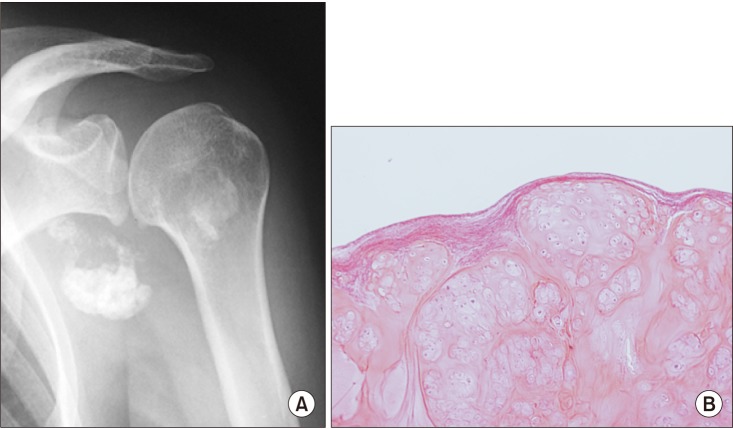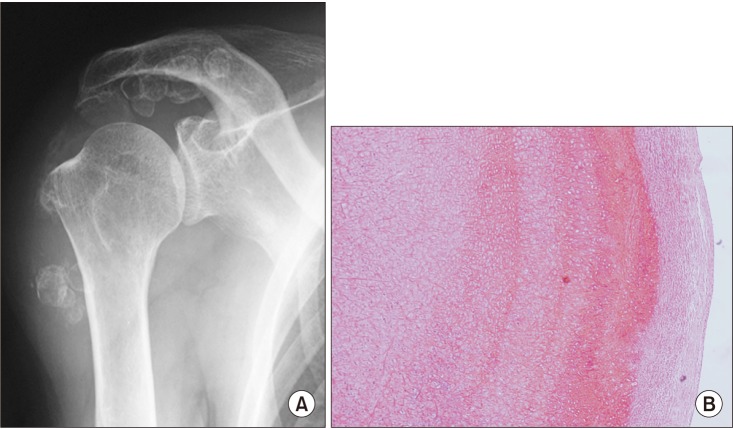Clin Orthop Surg.
2020 Mar;12(1):68-75. 10.4055/cios.2020.12.1.68.
Clinical Results of Surgical Resection and Histopathological Evaluation of Synovial Chondromatosis in the Shoulder: A Retrospective Study and Literature Review
- Affiliations
-
- 1Department of Orthopedic Surgery, Keio University School of Medicine, Tokyo, Japan. noboru18@gmail.com
- 2Department of Orthopedic Surgery, Eiju General Hospital, Tokyo, Japan.
- KMID: 2470053
- DOI: http://doi.org/10.4055/cios.2020.12.1.68
Abstract
- BACKGROUND
Synovial chondromatosis occurs rarely in the shoulder, and its details remain unclear. The purpose of this study was to clarify the clinical results of surgical resection and the histopathological findings of synovial chondromatosis in the shoulder.
METHODS
Ten shoulders with synovial chondromatosis that had been operatively resected were reviewed retrospectively. Osteochondral lesions were present in the glenohumeral joint in six shoulders and in the subacromial space in four shoulders. Two patients had a history of trauma with glenohumeral dislocation without recurrent instability, and the other seven patients (eight shoulders) did not have any traumatic episodes or past illness involving the ipsilateral shoulder girdle. The occurrences of osteochondral lesions, inferior humeral osteophytes, and acromial spurs were assessed on radiographs before resection, just after resection, and at final follow-up. The Constant scores were compared before resection and at final follow-up with Wilcoxon signed-rank tests. Resected lesions were histopathologically differentiated between primary and secondary synovial chondromatosis.
RESULTS
Inferior humeral osteophytes were found in five shoulders with synovial chondromatosis in the glenohumeral joint, and all four shoulders with synovial chondromatosis in the subacromial space had acromial spur formation. Osteochondral lesions appeared to have been successfully removed in all shoulders on postoperative radiographs. At the final follow-up, however, one shoulder with secondary synovial chondromatosis in the subacromial space showed recurrence of osteochondral lesions and acromial spur formation. The mean Constant score improved significantly from 53.0 points before resection to 76.0 points at a mean follow-up of 6.0 years (p = 0.002). On histopathological evaluation, one shoulder was diagnosed as having primary synovial chondromatosis, while nine shoulders had secondary synovial chondromatosis.
CONCLUSIONS
The present study showed that resection of shoulder osteochondral lesions successfully relieved the clinical symptoms and that primary synovial chondromatosis is less common than secondary synovial chondromatosis in the shoulder. Although most of the present osteochondral lesions were clinically determined to be primary chondromatosis, only one case was histopathologically categorized as primary synovial chondromatosis. These results suggest that histopathological identification is needed to differentiate between primary and secondary synovial chondromatosis.
Keyword
MeSH Terms
Figure
Reference
-
1. Jaffe HL. Synovial chondromatosis and other benign articular tumors. In : Jaffe HL, editor. Tumors and tumorous conditions of the bones and joints. Philadelphia, PA: Lea & Febiger;1958. p. 558–567.2. Mussey RD Jr, Henderson MS. Osteochondromatosis. J Bone Joint Surg Am. 1949; 31A(3):619–627. PMID: 18153904.
Article3. Milgram JW. The classification of loose bodies in human joints. Clin Orthop Relat Res. 1977; (124):282–291.
Article4. Ho YY, Choueka J. Synovial chondromatosis of the upper extremity. J Hand Surg Am. 2013; 38(4):804–810. PMID: 23474166.
Article5. Apte SS, Athanasou NA. An immunohistological study of cartilage and synovium in primary synovial chondromatosis. J Pathol. 1992; 166(3):277–281. PMID: 1381426.
Article6. Lunn JV, Castellanos-Rosas J, Walch G. Arthroscopic synovectomy, removal of loose bodies and selective biceps tenodesis for synovial chondromatosis of the shoulder. J Bone Joint Surg Br. 2007; 89(10):1329–1335. PMID: 17957072.
Article7. Villacin AB, Brigham LN, Bullough PG. Primary and secondary synovial chondrometaplasia: histopathologic and clinicoradiologic differences. Hum Pathol. 1979; 10(4):439–451. PMID: 468226.8. Xu C, Yang X, Zhao J. Arthroscopic treatment for synovial chondromatosis of the subacromial bursa associated with partial rotator cuff tear. Knee Surg Sports Traumatol Arthrosc. 2015; 23(2):600–602. PMID: 25217318.
Article9. Ogawa K, Takahashi M, Inokuchi W. Bilateral osteochondromatosis of the subacromial bursae with incomplete rotator cuff tears. J Shoulder Elbow Surg. 1999; 8(1):78–81. PMID: 10077803.
Article10. Jeon IH, Ihn JC, Kyung HS. Recurrence of synovial chondromatosis of the glenohumeral joint after arthroscopic treatment. Arthroscopy. 2004; 20(5):524–527. PMID: 15122144.
Article11. Hamada J, Tamai K, Koguchi Y, Ono W, Saotome K. Case report: a rare condition of secondary synovial osteochondromatosis of the shoulder joint in a young female patient. J Shoulder Elbow Surg. 2005; 14(6):653–656. PMID: 16337537.
Article12. De Ferm A, Lagae K, Bunker T. Synovial osteochondromatosis: an unusual cause for subacromial impingement. Acta Orthop Belg. 1997; 63(3):218–220. PMID: 9415731.13. Volpin G, Nerubay J, Oliver S, Katznelson A. Synovial osteochondromatosis of the shoulder joint. Am Surg. 1980; 46(7):422–424. PMID: 7447180.14. Carpintero P, Luque A, Serrano J. Recurrent osteochondromatosis of the shoulder in a child. Orthopedics. 1998; 21(3):361–362. PMID: 9547821.
Article15. Kawasaki T, Imanaka T, Matsusue Y. Synovial osteochondromatosis in bilateral subacromial bursae. Mod Rheumatol. 2003; 13(4):367–370. PMID: 24387262.
Article16. Brodsky AE. Synovial osteochondromatosis of the shoulder. Bull Hosp Joint Dis. 1950; 11(1):14–25. PMID: 14783699.17. Devgan A, Gupta V, Magu NK, Rohilla R. Primary combined intra-articular and extra-articular synovial osteochondromatosis of shoulder: a case report. Chin Med Sci J. 2014; 29(4):248–250. PMID: 25429753.
Article18. Milgram JW, Hadesman WM. Synovial osteochondromatosis in the subacromial bursa. Clin Orthop Relat Res. 1988; (236):154–159.
Article19. Butt SH, Muthukumar T, Cassar-Pullicino VN, Mangham DC. Primary synovial osteochondromatosis presenting as constrictive capsulitis. Skeletal Radiol. 2005; 34(11):707–713. PMID: 16132979.
Article20. Jones GC, Riley GP, Buttle DJ. The role of proteases in pathologies of the synovial joint. Int J Biochem Cell Biol. 2008; 40(6-7):1199–1218. PMID: 18339575.
Article21. Ranalletta M, Bongiovanni S, Calvo JM, Gallucci G, Maignon G. Arthroscopic treatment of synovial chondromatosis of the shoulder: report of three patients. J Shoulder Elbow Surg. 2009; 18(3):e4–e8.
Article22. Horii M, Tamai M, Kido K, Kusuzaki K, Kubo T, Hirasawa Y. Two cases of synovial chondromatosis of the subacromial bursa. J Shoulder Elbow Surg. 2001; 10(2):186–189. PMID: 11307084.
Article23. Ji JH, Shafi M, Jeong DS. Secondary synovial chondromatosis of the shoulder. Knee Surg Sports Traumatol Arthrosc. 2015; 23(9):2624–2627. PMID: 24803015.
Article24. Seltzer SE, Weissman BN. CT findings in normal and dislocating shoulders. J Can Assoc Radiol. 1985; 36(1):41–46. PMID: 3980551.25. Weinstein DM, Bucchieri JS, Pollock RG, Flatow EL, Bigliani LU. Arthroscopic debridement of the shoulder for osteoarthritis. Arthroscopy. 2000; 16(5):471–476. PMID: 10882441.
Article26. Kellgren JH, Lawrence JS. Radiological assessment of osteoarthrosis. Ann Rheum Dis. 1957; 16(4):494–502. PMID: 13498604.
Article27. Yucel B, Mutlu S, Komur B, Mutlu H. Arthroscopic removal of giant loose bodies in the glenohumeral joint. Int J Surg Case Rep. 2014; 5(8):459–461. PMID: 24973527.
Article28. Huang TF, Wu JJ, Chen TS. Bilateral shoulder bursal osteochondromatosis associated with complete rotator cuff tear. J Shoulder Elbow Surg. 2004; 13(1):108–111. PMID: 14735086.
Article29. Katoh H, Ogawa K, Ikegami H, Inokuchi W, Toyama Y. Osteochondromatosis of the shoulder in a twelve-year-old boy. J Shoulder Elbow Surg. 2007; 16(1):e15–e19.
Article30. Milgram JW. Synovial osteochondromatosis: a histopathological study of thirty cases. J Bone Joint Surg Am. 1977; 59(6):792–801. PMID: 908703.31. Chillemi C, Marinelli M, de Cupis V. Primary synovial chondromatosis of the shoulder: clinical, arthroscopic and histopathological aspects. Knee Surg Sports Traumatol Arthrosc. 2005; 13(6):483–488. PMID: 15726326.
Article32. Sah AP, Geller DS, Mankin HJ, et al. Malignant transformation of synovial chondromatosis of the shoulder to chondrosarcoma: a case report. J Bone Joint Surg Am. 2007; 89(6):1321–1328. PMID: 17545437.



